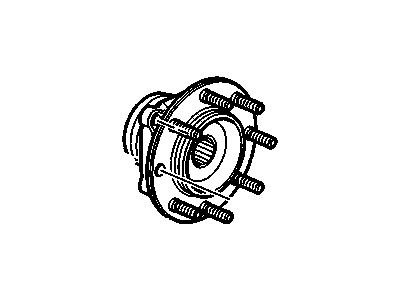
My Garage
My Account
Cart
Genuine Pontiac Fiero Wheel Hub
Wheel Axle Hub- Select Vehicle by Model
- Select Vehicle by VIN
Select Vehicle by Model
orMake
Model
Year
Select Vehicle by VIN
For the most accurate results, select vehicle by your VIN (Vehicle Identification Number).
1 Wheel Hub found
Pontiac Fiero Front Wheel Bearing (W/Bearing)
Part Number: 7470002$78.82 MSRP: $165.90You Save: $87.08 (53%)
Pontiac Fiero Wheel Hub
This component referred to as the Wheel Hub of the vehicles came into our discussion in relation with Pontiac Fiero where it plays a vital connection between the wheels and the vehicle where safety of the wheels and smooth rotation is well enhanced. In it shelter various functional parts such as wheel bearing and brake system thus playing vital roles in steering, acceleration among other factors. Pontiac Fiero uses a Wheel Hub Assembly (WHA) with splines that act as teeth to transmit power and roller bearing for the rotational movement of non-drive wheels. Specific bolt pattern and specifications of the Wheel Hub used on Pontiac Fiero models have been described over the years having different designs. It is always important when working on a Wheel Hub that the replacement unit is a direct replacement for the automobile in consideration to enhance its performance. The cost of a replacement may yet again depend on the model year and or components but affordable but OE-grade products are available in the market.
Each OEM Pontiac Fiero Wheel Hub we offer is competitively priced and comes with the assurance of the manufacturer's warranty for the part. Furthermore, we guarantee the speedy delivery of your orders right to your doorstep. Our hassle-free return policy is also in place for your peace of mind.
Pontiac Fiero Wheel Hub Parts Questions & Experts Answers
- Q: How to properly replace a Wheel Hub assembly on Pontiac Fiero?A:Loosen but do not remove the wheel lug nuts, then raise the rear of the vehicle and secure it on jackstands. Remove the tire and wheel assembly, followed by the parking brake cable and spring from the lever on the backside of the caliper, and the brake hose bracket from the strut. Next, remove the caliper mounting bolts and the caliper, hanging the caliper out of the way with a piece of wire. Proceed to remove the brake disc and the hub nut, discarding it and using a screwdriver to hold the flange stationary while breaking the hub nut loose. Remove the three shield mounting bolts and the shield, ensuring the hub nut is removed first. If reusing the same hub and bearing assembly, mark the relationship of the hub and bearing assembly flange to the knuckle. Use a puller to remove the hub and bearing assembly, then clean and inspect the bearing mating surfaces and the knuckle bore for dirt, nicks, and burrs, noting that the hub and bearing assembly must be replaced as a unit if damaged. If installing a new hub and bearing assembly, pry out the knuckle seal and drive the new seal into the knuckle bore with a large socket. Push the hub and bearing onto the axleshaft, ensuring alignment marks are matched if reusing the old assembly. Install the shield and shield mounting bolts, tightening them to the specified torque, then install the new hub nut and apply the initial specified torque to seat the hub and bearing assembly. Install the disc and caliper assemblies along with the parking brake cable and spring, followed by the tire and wheel assembly, ensuring not to install the plastic wheel cover if equipped with standard steel wheels. Tighten the wheel lug nuts securely, lower the vehicle, and tighten the hub nut to its final specified torque. If equipped with standard steel wheels, raise the vehicle again, secure it on jackstands, remove the wheel lug nuts, install the plastic wheel cover, and reinstall the wheel lug nuts finger tight before lowering the vehicle and tightening the wheel lug nuts to the specified torque.






